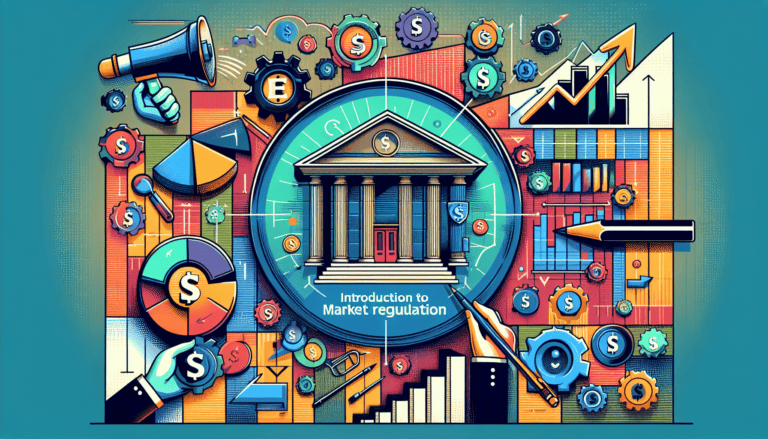The Digital Revolution: Unraveling the Connection between Financial Markets and Technology

Introduction to Financial Markets
Financial markets play a pivotal role in the global economy, acting as the backbone for facilitating the exchange of financial assets and fostering economic growth. They are complex systems where securities are issued, bought, and sold. For beginner investors, understanding the mechanisms and instruments of financial markets is a foundational step towards informed investing.
The Role of Markets
The primary function of financial markets is to efficiently allocate resources and create liquidity in the economy. They serve as a platform where investors can purchase securities, such as stocks and bonds, thus providing capital to corporations, governments, and other entities. These markets support price discovery, where the forces of supply and demand determine the value of financial instruments. They also provide an avenue for risk management, enabling investors and institutions to hedge against various types of financial risks.
The interconnectivity of financial markets and technology has significantly enhanced market efficiency, allowing for swift transactions and better accessibility for investors across the globe. Technology has also bolstered market efficiency theory by streamlining the flow of information, which in turn aids in understanding market sentiment and the overall financial markets and the economy.
Types of Financial Instruments
Financial instruments are the assets or packages of capital that can be traded in these markets. They typically fall into two broad categories: equity and debt. Equity instruments, like stocks, represent ownership in a company, while debt instruments, like bonds, represent a loan made by the investor to the borrower.
| Instrument Type | Description | Examples |
|---|---|---|
| Equity | Ownership stake in an entity | Stocks, Exchange-Traded Funds (ETFs) |
| Debt | Loan from an investor to a borrower | Bonds, Mortgages |
| Derivatives | Financial contracts whose value is derived from an underlying asset | Options, Futures |
Investors can engage in various market environments such as primary vs. secondary markets, public and private markets, and international financial markets. Each of these markets has different characteristics, participants, and regulatory frameworks, which can be explored further in our articles on introduction to market regulation and the role of central banks in financial markets.
As technology continues to evolve, it plays a crucial role in shaping the landscape of financial markets. From the way investors manage their portfolios (introduction to portfolio management) to the emergence of digital currencies and platforms, the fusion of financial markets and technology is creating new paradigms in investing. For a deeper look into how these technological advancements impact financial markets, readers may explore future trends in financial markets and the impact of globalization on financial markets.
Technology’s Impact on Finance
Technology has become a cornerstone in the evolution of financial markets, revolutionizing how financial data is processed, analyzed, and shared. The advancements in financial technology have paved the way for more accurate reporting systems and enhanced real-time data analysis, fundamentally altering the landscape of finance.
Automated and Accurate Reporting
The advent of technology in financial reporting has increased exponentially in recent years, resulting in more precise and efficient data analysis and reporting processes (Planergy). Automated financial reporting systems have been instrumental in reducing the risk of manual errors and ensuring uniformity in financial data across various reports and timeframes. This automation has been a significant step forward in understanding market liquidity and market efficiency theory.
Automation in financial reporting not only streamlines the process but also provides a level of accuracy that manual processes could not consistently achieve. With the implementation of these systems, financial institutions can now generate reports that reflect true and fair views of financial positions, supporting introduction to portfolio management and key players in financial markets.
Real-Time Data and Collaboration
The use of cloud-based financial reporting systems has been a game-changer, enabling instantaneous access to financial data. Such systems facilitate collaboration and communication among various stakeholders, irrespective of their geographical distribution (Planergy). This aspect of technology is particularly beneficial in grasping market cycles and economic indicators and enhancing the function and role of financial markets.
Moreover, the integration of real-time data capabilities within financial reporting tools has significantly improved decision-making processes. Stakeholders can now receive timely and precise financial information that is critical for strategic planning and investment choices, fostering a deeper understanding of market sentiment and informing future trends in financial markets.
In summary, the impact of technology on finance has been profound and multifaceted. From automated and accurate reporting to real-time data and collaboration, these advancements have not only improved financial reporting and analysis but have also democratized access to financial markets, opening new avenues for beginner investors. As technology continues to evolve, the financial landscape is expected to undergo further transformation, with emerging opportunities and risks alike.
Investment Tools and Platforms
The infusion of technology into finance has revolutionized the way individuals and institutions invest in financial markets. With the advent of advanced investment tools and platforms, the investment landscape has become more accessible and efficient. This section explores electronic and algorithmic trading as well as robo-advisors and artificial intelligence (AI), which are two key facets of modern investment technology.
Electronic and Algorithmic Trading
Electronic trading has transformed financial markets, enabling faster and more efficient transactions. This digitization of trading includes algorithmic trading and high-frequency trading, which leverage complex algorithms to execute trades at speeds and volumes that are impossible for human traders. According to GeeksforGeeks, these technologies have significantly enhanced market speed and efficiency.
Algorithmic trading uses predefined criteria, such as timing, price, and volume, to automate trading instructions. High-frequency trading, a subset of algorithmic trading, involves executing a large number of orders at rapid speeds, often capitalizing on minute price discrepancies.
These advancements have also contributed to improved market liquidity and efficiency, aligning with the broader market efficiency theory. As these technologies continue to evolve, they also play a significant role in understanding market sentiment.
Robo-Advisors and AI
Robo-advisors are automated investment platforms that utilize algorithms to deliver personalized financial advice and portfolio management. As EverFi and Forbes report, these platforms have become increasingly popular due to their low fees and user-friendly interfaces. They cater to investors who are looking for a hands-off approach to portfolio management.
AI is a driving force behind many of these robo-advisors, analyzing vast amounts of data to predict market trends and generate investment insights. AI-driven trading algorithms were responsible for over 60% of US equity trading volume in 2020, showcasing their dominance in the market (Source).
Furthermore, AI is disrupting traditional investing methods by enabling individual and corporate investors to refine their strategies and operational models (TechZone360). With the aid of these innovative technologies, investors can now manage their investments more effectively, enjoying a level of customization and control that was previously exclusive to professional fund managers.
As the financial world continues to embrace digital solutions, the intersection of financial markets and technology is likely to deepen, paving the way for more sophisticated investment tools and platforms. This digital shift is not only changing how investments are made but also democratizing access to financial markets, allowing more people to participate in the investment process, as seen in the rise of passive funds and self-managed portfolios (TechZone360). The future of investing is increasingly digital, and understanding these tools and platforms is essential for anyone looking to navigate the evolving landscape of financial markets and technology.
Technology in Market Analysis
The fusion of financial markets and technology has led to significant advancements in how market analysis is conducted. Two revolutionary forces—big data and artificial intelligence (AI)—have emerged as cornerstones in modern financial decision-making processes.
Big Data in Financial Decisions
Big data refers to the vast volumes of structured and unstructured data that are too complex for traditional data-processing software to manage efficiently. In the context of financial markets, big data encompasses market transactions, social media, news reports, economic indicators, and more. This wealth of data offers a panoramic view of market conditions that can influence investment strategies and portfolio management.
Financial institutions harness big data to glean insights into market sentiment, liquidity, and market cycles. Moreover, big data analytics enables more precise risk assessment, potentially enhancing market efficiency theory. By providing a more comprehensive understanding of market dynamics, big data empowers investors to make more informed decisions.
AI for Predictive Insights
Artificial intelligence, particularly machine learning algorithms, is revolutionizing market analysis by providing predictive insights that were previously unattainable. AI systems analyze large amounts of financial data to identify patterns, trends, and anomalies, offering a competitive edge to those who utilize them.
In 2020, AI-driven trading algorithms accounted for more than 60% of US equity trading volume, signifying an industry-wide reliance on these advanced tools (Source). AI applications in finance range from forecasting the future performance of stocks to automating customer service and enhancing fraud detection (Global Youth Wharton).
Investors leverage AI to navigate the complexity of international financial markets and to stay ahead of rapid market changes. Furthermore, AI’s predictive capabilities are essential for financial institutions aiming to improve their operational efficiency and provide better services to their clients.
With the relentless advancement of technology, the intersection between financial markets and technology will continue to deepen, presenting both opportunities and challenges. As investors and analysts become more adept at using these tools, the financial landscape will inevitably evolve, marking a new era in market analysis and investment strategies. For further exploration of how technology shapes the financial realm, readers may delve into future trends in financial markets.
Emerging Opportunities
The intersection of financial markets and technology has ushered in a new era of investment possibilities. Emerging opportunities, particularly in the realms of cryptocurrencies and blockchain technology, as well as innovations in financial technology (fintech), are reshaping how investors interact with the financial markets.
Cryptocurrencies and Blockchain
Cryptocurrencies and blockchain technology have garnered significant attention as revolutionary contributors to financial markets. The decentralized nature of blockchain offers a secure and transparent ledger system, transforming how transactions are recorded, reducing associated costs, and increasing operational efficiency. This technology holds the promise of eliminating the need for intermediaries, such as banks and brokers, which could lead to more direct and streamlined trading processes.
According to a study, the application of blockchain technology in financial markets could lead to an annual cost reduction of $20 billion by 2022 (Source). The technology’s impact extends beyond mere cost savings; it is poised to redefine the structure and functioning of financial markets.
| Technology | Potential Impact |
|---|---|
| Cryptocurrencies | Alternative investment assets, decentralized finance |
| Blockchain | Secure transaction recording, reduced need for intermediaries |
For those new to the investment world, it’s crucial to understand not just the potential of cryptocurrencies as an asset class but also the foundational role blockchain can play in the future trends in financial markets.
Fintech Innovations
Fintech, a blend of finance and technology, has surged with startups and established companies alike introducing advanced solutions that challenge traditional financial paradigms. These innovations range from peer-to-peer lending platforms and digital payment systems to crowdfunding and automated wealth management services (Forbes).
Investopedia highlights how fintech companies have utilized the internet to create tools that automate and simplify investment processes. These tools include robo-advisors for automated portfolio management, algorithmic trading for high-speed and precise transactions, and integrated platforms that offer real-time data and analytics.
Investors now have access to a plethora of tools designed to enhance decision-making and optimize investment strategies. The synergy between technology and financial markets has democratized access, enabling even novice investors to make informed decisions with ease.
| Fintech Solution | Function |
|---|---|
| Robo-Advisors | Automated investment management |
| Algorithmic Trading | High-speed, data-driven trading |
| Digital Payments | Streamlined online transactions |
| Crowdfunding Platforms | Collective investment opportunities |
As these technological advancements continue to evolve, they represent significant opportunities for individuals to engage with the financial markets in ways that were previously inaccessible. By leveraging these innovations, investors can navigate the function and role of financial markets with greater confidence and efficiency.
Risks and Cybersecurity
The intersection of financial markets and technology has brought forth a myriad of advancements and efficiencies. However, it also introduces several risks and cybersecurity challenges that need to be managed with due diligence to ensure the stability and security of financial systems.
Managing Technological Risks
The advent of digital technologies in finance has been instrumental in creating more efficient and effective operations. Nonetheless, such reliance also presents reputational, legal, and financial risks that have escalated in recent years (McKinsey). To navigate these risks, financial institutions must adopt a comprehensive risk strategy that is embedded within the organization’s culture.
Key components of managing technological risks include:
- Establishing a new risk strategy and culture that aligns with technological advancements.
- Ensuring that both operational staff and board members have the necessary attention, knowledge, and support to manage these risks effectively.
- Shifting the organizational mindset from mere governance to reinforcing behaviors that align with the desired risk culture.
Financial institutions have to strike a balance between leveraging technology for growth and managing the associated risks. This involves clearly defining acceptable levels of risk, devising actions to mitigate these risks, and communicating these measures effectively to mobilize the workforce (McKinsey).
Cybersecurity Measures
Cybersecurity has become a critical concern in the financial sector, especially as technological advancements heighten the potential for cyber threats. To safeguard customer data and prevent unauthorized activities, financial institutions are significantly investing in cybersecurity infrastructure.
Robust cybersecurity measures are essential to protect the integrity of financial markets and maintain customer trust. These measures include:
- Implementing advanced encryption methods to secure data transmission.
- Conducting regular security audits and vulnerability assessments.
- Employing multi-factor authentication and continuous monitoring to detect and prevent unauthorized access.
- Providing regular training to employees on cybersecurity best practices and emerging threats.
- Developing and testing incident response plans to address potential security breaches swiftly.
Financial institutions must stay ahead of cyber threats by continually updating and refining their cybersecurity strategies. This includes staying informed about the latest developments in cybersecurity technology and adapting their defenses accordingly.
By prioritizing both the management of technological risks and the enhancement of cybersecurity measures, financial institutions can secure their operations against the evolving landscape of cyber threats. These efforts are crucial in maintaining the integrity of financial markets and the trust of investors and customers alike. For those new to the investment world, understanding the importance of these measures is a foundational aspect of navigating financial markets and technology.
The Future of Investing
In the realm of finance, the rapid advance of technology heralds a new era for investors. With digital transformation reshaping the landscape, investors are gaining access to tools and platforms that were once the sole preserve of professionals. Understanding the intersection of financial markets and technology is essential for beginner investors seeking to navigate the evolving world of investment.
Digital Transformation
Digital transformation in financial markets is effectively democratizing investing, making it more accessible to a wider audience. Technological advancements have streamlined many processes, from market analysis to trade executions, ushering in a new level of market efficiency. Individuals new to investing can benefit from exploring how this transformation impacts market efficiency theory and the role of central banks in financial markets.
As reported by TechZone360, the use of Artificial Intelligence (AI) is disrupting the investing world, playing a pivotal role in stock analysis and trading strategy implementation. AI’s integration into financial markets is not just limited to individual investors but is also revolutionizing how corporate investors refine their operational models.
The digital era also brings a shift in investment products. Passive funds, known for tracking market indices, have eclipsed actively managed funds in popularity, indicating a trend where investors are taking more control over their own portfolios. This shift underscores the importance of understanding market sentiment and introduction to portfolio management.
Retail Investors and Online Trading
The surge in online trading platforms has significantly lowered the barriers to entry for investing, particularly among millennials. With over three billion smartphone users worldwide, mobile investing allows traders to manage their portfolios and access financial news anytime, anywhere. This shift toward mobile and online trading platforms has been instrumental in the increase of retail investors, who now represent an all-time high of 25% of the market.
For retail investors, knowledge of primary vs. secondary markets, public and private markets, and introduction to financial market instruments is invaluable in making informed decisions. Additionally, staying informed about future trends in financial markets can help investors capitalize on emerging opportunities.
The table below reflects the growing preference for online trading:
| Year | Percentage of Retail Investors |
|---|---|
| Before 2010 | <10% |
| 2021 | 25% |
(Source: TechZone360)
As technology revolutionizes the financial industry, it is imperative for investors to stay abreast of changes and adapt accordingly. By leveraging digital tools and platforms, retail investors can gain a competitive edge in their investment strategies. Embracing the digital future of investing involves a continuous learning process, including deepening one’s understanding of the impact of globalization on financial markets, ethics and corporate governance, and the intricate function and role of financial markets.





